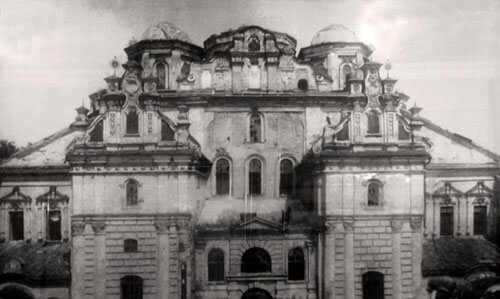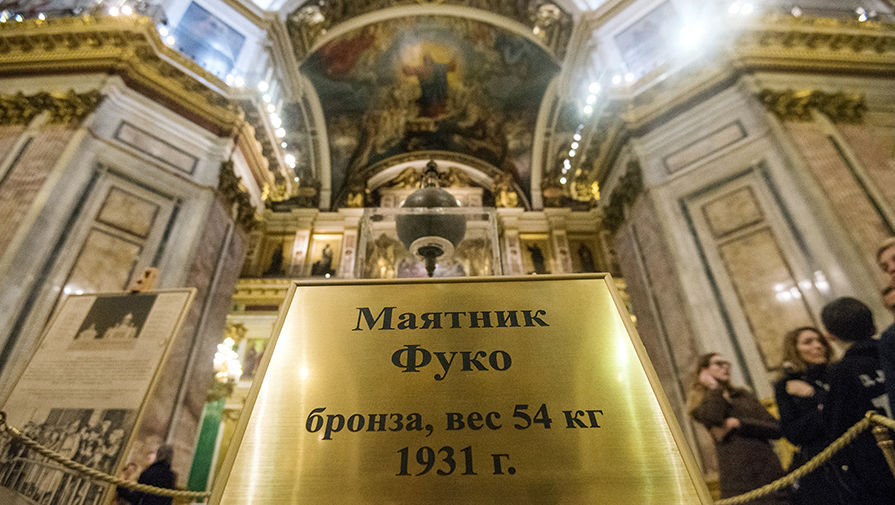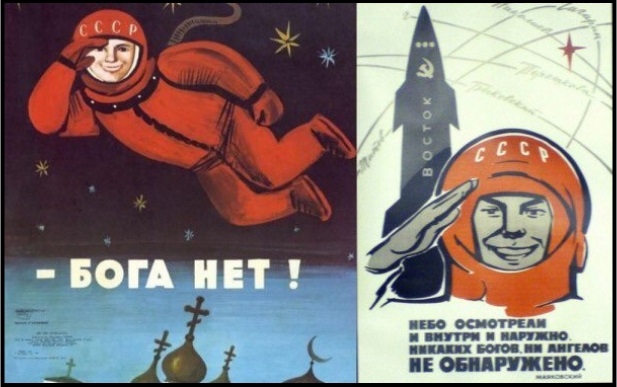Studying the difficult period of Ukrainian history, which covers the first half of the twentieth century, many people wonder how the Reds were able to defeat their political opponents and then stay in power for more than 70 years. There are many explanations for this. One of them is that, unlike in modern Russia, where propaganda is actually turned back in time and operates with ideological constructions dating back several hundred years, the Bolsheviks proclaimed their state project “progressive” aiming to cancel outdated “old world” all around. Under this pretext, they began to demonstratively introduce the scientific worldview and fight against “obscurantism,” allegedly embodied in religion.
At first, everything looked quite civilized: the Soviet government proclaimed the separation of church and state (which was quite a progressive step at the time) and the communists fought it only “on the ideological front.” For some time, there was even some “flirting” with the Orthodox clergy: On November 10, 1917, with the assistance of the new government, they officially restored the position of “Patriarch of Moscow and All Russia,” abolished two centuries earlier. But as early as 1925, the Union of Militant Atheists was created, a seemingly voluntary organization that was in fact actively supported by government. The government also financed the publishing of the Bezbozhnyk (The Godless) newspaper, the Atheist magazine, and other literature of a similar orientation, and organized public lectures and film screenings.

When Dzhugashvili-Stalin finally gained power, he naturally saw the church as a competitor for “influence on human souls.” After the death of Patriarch Tikhon in April 1925, the position was left virtually vacant; the “acting” Metropolitan Peter was arrested at the end of the same year, and since then the Russian Orthodox Church has been led by his deputy, Metropolitan Sergius, who was determined to cooperate with the “godless state.” Then soviets started to arrest Orthodox clergy who disagreed with this position, as well as representatives of other faiths. Another way of fighting the church was the direct destruction of religious buildings. In Kyiv alone, more than a hundred were destroyed, the most famous of which are the later rebuilt St. Michael’s Cathedral and Assumption Cathedrals.
However, some buildings, such as St. Sophia of Kyiv, were saved and granted the status of a cultural monument. Another way to save them was to “change the intended purpose”: clubs, cinemas, concert halls, and simply storage facilities were organized in church buildings. The most fortunate were those churches that were turned into museums. However, these museums often had a very specific focus.

On April 12, 1931, the State Anti-Religious Museum was opened in St. Isaac’s Cathedral, the largest Orthodox church in St. Petersburg, with a demonstration of the world’s largest Foucault pendulum. We should remind here that St. Petersburg was the capital of Russia before the Bolshevik revolt, so the most magnificent temples in Empire were built there. Experiments with this pendulum once proved that the Earth rotates on its own axis, which the church allegedly did not want to admit (as well as the fact that our planet is spherical, which few people have actually questioned since antiquity). The following year, the Museum of the History of Religion and Atheism was opened in the Kazan Cathedral, the second largest church in St. Petersburg. Only in 1991 did services resume in this cathedral, and it was finally returned to the Orthodox Church in 2000.
Temples converted into planetariums
The “triumphal procession of the scientific worldview” was interrupted by the attack on the USSR by Nazi Germany. In the occupied territories, the Germans resumed the activities of church communities and the operation of temples (those that had not been destroyed). By doing so, they initially earned some favor with the local population, which was unacceptable from the point of view of the Soviet government. The top leadership of the USSR had to soften its attitude toward religion, stop arresting priests, and even finally “legalize” the position of patriarch, which was held by the aforementioned Metropolitan Sergius. After the war ended, the period of “warming” of relations between the state and the church lasted for some time, with one important clarification: it concerned almost exclusively the Russian Orthodox Church of the Moscow Patriarchate and the Georgian Orthodox Church. The activities of all other denominations continued to be, if not outright prohibited, then greatly disapproved and complicated.
But this “warming” could not last long. It ended with the demonstrative termination of the activities of the Union of Militant Atheists in 1947. Its property was transferred to the State Society for the Dissemination of Political and Scientific Knowledge. Then a wave of repression of religious leaders and the closure of churches swept across the country. However, a new use was found for some of them: large church domes were well suited for demonstrating the artificial starry sky with the help of planetarium device.
The first such planetarium — by the way, it was only the second planetarium in the USSR after the Moscow one — was opened in 1948 in the former St. Alexei’s Church in the city of Gorky (now Nizhny Novgorod). This was followed by a similar “re-profiling” of the Church of the Exaltation of the Cross in Barnaul, and then the Church of St. John the Theologian in Kostroma. On January 1, 1952, the Kyiv Planetarium was opened in the building of St. Alexander’s Church. It took 35 years to relocate it to a separate specially built building.
Religion and astronautics
The achievements of Soviet science and technology, which were truly impressive at the time, added to the pathos of anti-religious figures: On October 4, 1957, the first artificial satellite entered Earth orbit, and on December 5, the nuclear icebreaker Lenin was launched. And all this happened without any participation of priests with their incense and prayers. The church was persistently turned into a subject for caricatures… but at the same time, many party and state figures continued to participate in church rites… of course, they did it underground, but rumors still leaked out.
Such a hypocritical attitude by state officials toward the religion naturally discredited anti-church propaganda. Its intrusiveness and clumsiness also contributed to disrespect. The slogan “Gagarin flew into space, but did not see God” sounded unconvincing after a visiting lecturer’s lecture in a village club, which spoke about the infinity of the universe. And after the Vostok program was declassified, when the capsule in which Gagarin made his historic orbital journey was put on public display, one of the sightseers exclaimed, “What could he see through such a tiny window?” (Vostok’s windows were indeed less than 30 cm in diameter).

After Nikita Khrushchev was ousted from power, things in Soviet cosmonautics went much worse. In April 1967, Vladimir Komarov was killed during the testing of a new spacecraft, and then the USSR lost the “lunar race“… At the same time, the attitude toward religion gradually became more lenient. Museums and educational centers that opened in the 1970s no longer had an overtly atheistic orientation. This was the case, for example, with the Museum of the History of Religion, which was created in the buildings of the Dominican monastery in Lviv.
“The “reconciliation” with the Orthodox Church and the gradual easing of restrictions on the activities of other denominations helped improve the reputation of the “the most fair state of victorious socialism” in the international arena, which had been significantly damaged by the invasion of Czechoslovakia in 1968. To a certain extent, this worked, but after the coup in Afghanistan and the deployment of a “limited contingent” of Soviet troops, relations with many countries (now including Islamic ones) deteriorated again. Finally, Gorbachev’s “perestroika” lifted all religious restrictions, but this could not save the giant country, which was finally destroyed by economic problems. It collapsed. And at this time, the surviving churches began to open, and participation in church life was no longer a ground for persecution. Anti-religious propaganda ceased to receive state support, finally taking its rightful place as one of the points of view in broad worldview discussion.
* * *
But when dealing with Russia, it is useless to expect some prudence, some sense of equilibrium, some idea of “golden mean.” Not much time has passed since the abandonment of “state atheism,” when the huge country has been mired in total, ostentatious religiosity. In quite a natural way, Moscow Orthodoxy was chosen as ” the only true faith,” but soon enough Islam started gradually being added to it. Since 1998, the Baikonur Cosmodrome has begun to get launch vehicles and spacecraft blessed by priests before launch. Such a blatant ideological return to hundred-years-old practices looks crazy from the point of view of a normal modern person, but it seems that the vast majority of Russians are quite comfortable about that.
All of this would look like a bad joke, but when put into practice, it becomes more like some kind of bizarre experiment to find out how successful the combination of ideological archaism and modern technology will be. It might even be quite interesting to watch that weird show… but alas the country that willingly became a “test subject” now tries to forcefully extend this experiment to its neighbors under the guise of “preserving values” and “protecting civilization.” Actually, in the 1930s, one European state already tried to do something similar… with very sad consequences for the whole world. We hope that this time the world will be able to stop the “experimenter” before he has time to cause irreparable damage to the planet!
Earlier, we wrote about the origins of the date of Christmas.

